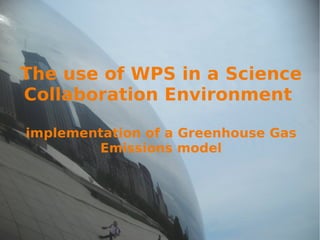Ifgi presentation
- 1. The use of WPS in a Science Collaboration Environment implementation of a Greenhouse Gas Emissions model
- 2. Topics Introduce Landcare Research Our Vision Architecture Model implementation Closing thoughts Previous slide: Cloud Gate, Chicago. Photo: Niels Hoffmann
- 3. Manaaki Whenua - Manaaki Tangata care for the land - care for the people http://www.landcareresearch.co.nz Sustaining biodiversity & restoration Sustaining land environments Sustaining business & living Climate change Maori sustainable futures Weeds, pests and diseases Capability and collaboration Landcare Research Manaaki Whenua Key outcomes Cross-cutting outcomes Underpinning strengths
- 4. LRIS: Land Resource Information System 1978-2008+ NZLRI NZLRI NSD Soil DB S-map Soil DB : National Coverage of Environmental Data at 1:50:000 to 15m resolution : Leading the Implementation of geospatial web-delivery in NZ S-Map soil NZLRI ECOSAT veg Curvature horiz Curvature perp Curvature slope S-map Landform Elements S-map siblings S-map pedo-func S-map variability Height Aspect Slope FSL:Phys FSL:Chem FSL:Wet FSL:Env NZEEM Soil loss tons/ha/yr ECOSAT fPAR ECOSAT Woody ECOSAT Indig. Forest PinRadGrow FertReq StockCCap LUNZ & LENZ Rock Slope Soil Erosion Veg LUC
- 5. Observations Data and Computational pressure: NOW – 25m national data density NEAR FUTURE – sub 5m national data density with significant peri-urban sub 1m LIDAR data density Modelling environment NOW – essentially batch oriented & 2.5D DESIRED – interactive 4D, with real-time visualisation feedback Managed data NOW – preserve the data, memorise the model DESIRED – keep the model for on-demand re-use
- 6. The Vision: SCENZ-Grid SCE NZ-Grid proposes that we can: Do science research on-line together Share each other’s data – not duplicate it Collaboratively develop & use shared models / workflows Use shared compute resources Connect researchers directly to consumers : policy / managers / educators / public
- 7. Phase 1: Regolith Portlet REANNZ funded project (2007-2009): GNS and Landcare Research QMAP WMS NZFSL WMS Lookup WS Portal User WF Engine User Interface View Portlet WebService WorkFlow Engine Model Kepler Mono / Java class Web Services Data: WMS Business Logic: SOAP
- 8. Phase 2: Platform FRST Backbone funding and BeSTGRID integration (2009-)
- 9. 'SDI' Find Koordinates Visualize Geoserver / OL Process 52N WPS
- 10. WPS Geoserver Globus / Grisu ~1.16 TFLOPS Air cooled Gb Ethernet nterconnects 4.2kW power 104 Intel Xeon cores 2.8GHz each 386GB RAM 2.6TB storage
- 11. WPS Extensions: Computation - Collaboration WPS – G Current: Unicore, Gridgain Planning to implement Grisu => waiting for release v3 WPS – T Started porting to Apache ODE 80% complete, need to refactor the execute part to use the new(er) architecture
- 12. LCR Algorithm Repository LCR (Landcare Research) Specific algorithms Raster implementations: Emissions Modeling Landcare repository Sextante repository
- 13. Modularity Algorithms: fully modular
- 14. Parsers: problem with xml parser Diff requestHandler (left lcr branch, right trunk)
- 15. Emissions Algorithm - inputs Landuse (dairy, sheep/beef, deer) Grid => WCS Geotiff Stocking rate (animals/ha) Table => xml Sheep/Beef Ratio (dependent per district) Grid => WCS Geotiff Methane + Nitrous Oxide => CO2eq/animal/year Table => xml
- 16. <ProcessDescription wps:processVersion="2" storeSupported="true" statusSupported="false"> <ows:Identifier>org.n52.wps.server.lcr.algorithm.EmissionsAlgorithm</ows:Identifier> <DataInputs> <ows:Identifier> landuse </ows:Identifier> <MimeType>image/tiff</MimeType> <ows:Identifier> districts </ows:Identifier> <MimeType>image/tiff</MimeType> <ows:Identifier> emissionslookup </ows:Identifier> <MimeType>text/XML</MimeType> <Schema>http://arwen/schemas/EmissionsTable.xsd</Schema> <ows:Identifier> stockingrate </ows:Identifier> <MimeType>text/XML</MimeType> <Schema>http://arwen/schemas/EmissionsTable.xsd</Schema> <ows:Identifier> districtlookup </ows:Identifier> <MimeType>text/XML</MimeType> <Schema> http://arwen/schemas/EmissionsTable.xsd </Schema> <ows:Identifier>result</ows:Identifier> <MimeType>image/tiff</MimeType> </ProcessDescription> Emissions Algorithm – link Value Attribute Table for Landuse and Districts XML Key-Value pair implementation Key = raster value, Value = list of attributes
- 17. Current Issues Fetching WCS coverages efficiently Crop to smallest extent
- 18. No checking for CRS validity Value Attribute Table implementation Custom XML / GeoTiff 'linkup' GMLJP2 ??? Client with raster capabilities
- 19. Closing thoughts (1) OGC Standards => Big and Bulky WPS very flexible but 'heavyweight' Like to be small and nimble (rest, custom architecture) Selling point for OGC is Interoperability need good clients => again difficult because of flexibility of standards WPS 2.0 profiles ?
- 20. Closing thoughts (2) WPS-G / Grid processing Scalability / high availability Easy to implement, but also possible via alternatives Parallelization new class of problems
- 21. No easy solution for splitting (spatial) problems
- 22. split/merge might still be the bottleneck
- 23. Questions ? [email_address] Milford Sound, NZ. Photo: Niels Hoffmann


















